The State of Decarbonization 2023
To view all of the survey results, download the eBook.
Executive Summary
The path to decarbonization is a critical focus across industries today. To overcome obstacles hindering our progress, we must identify common challenges organizations face in their decarbonization journey and share successful tactics.
To gain a deeper understanding, we engaged with the Eco Champions community—a convergence of energy, sustainability, and leadership teams working together for the common goal of decarbonization. Our primary objective was to capture and assess the decarbonization landscape, which involved evaluating various strategies, diving into the most effective tactics, and examining the challenges and motivating factors behind them.
By better understanding how organizations tackle these efforts, we can provide valuable best practices, insights and focus on strategies that have proven successful by peers. Together, we can make significant strides toward a more sustainable future.
Key findings:
- Over half of respondents have set decarbonization goals
- Viability and compliance are primary drivers for decarbonization
- Data access is the #1 challenge in the journey to decarbonization
- Energy data (Scopes 1 and 2) is a high priority for reporting
- Energy efficiency is the top priority
Methodology
The State of Decarbonization survey was conducted to better understand and assess the maturity scale of decarbonization efforts. Written responses from the survey were transcribed as-is into this eBook to maintain authenticity.
75% of our survey responses came from energy and sustainability professionals.
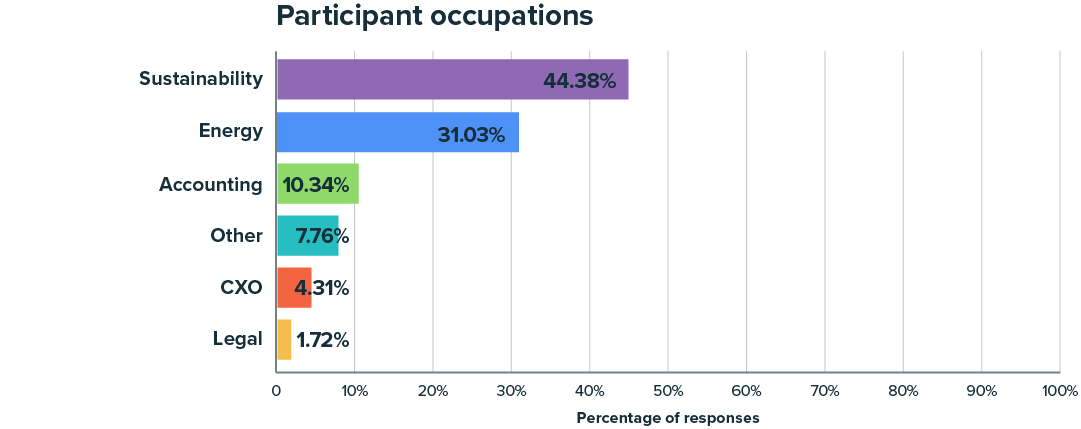
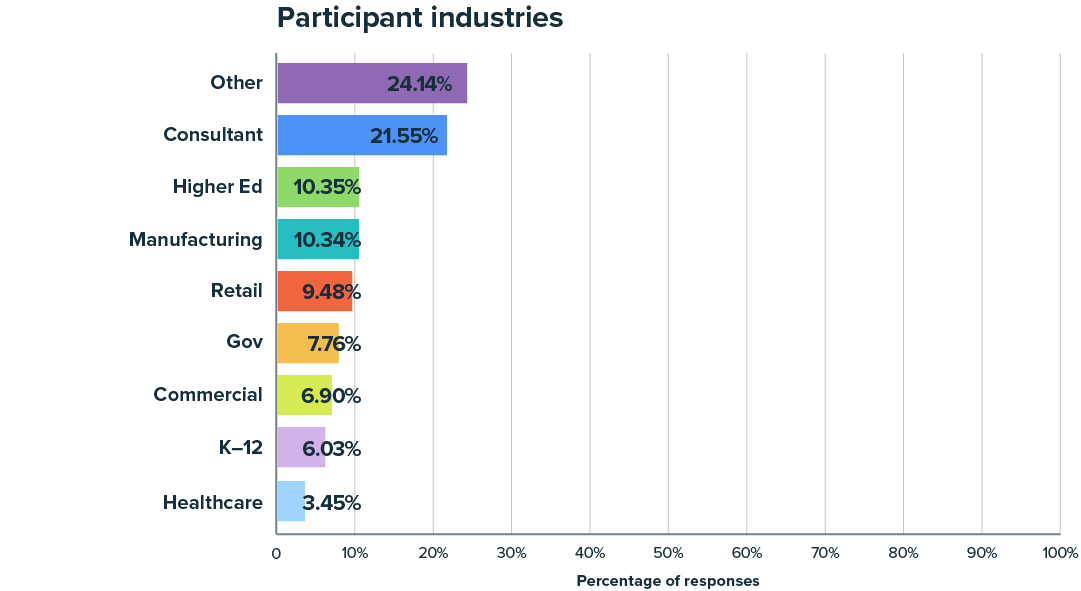
Over half of the respondents have said their organization has defined decarbonization goals.
44.83% of individuals responded that their organization has not yet defined decarbonization goals, while 55.17% said they have.

“We are looking to help our members reduce their carbon emissions by 50% from 2009 to 2030, and to meet the longer term internationally agreed goals thereafter.”
“Reduce absolute scope 1 & 2 GHG emissions by 80% and scope 3 GHG emissions by 50%, by 2030 from a 2019 baseline year. Net zero on or before 2040.”
“In the process of setting targets and strategy after releasing our first proper responsibility report this year for 2022.”
“We have a bold strategy to reduce our emissions by 50% in our own operations and make a substantial reduction in scope 3 as well by 2030.”
“40% reduction of Scopes 1 and 2 emissions by 2030 with 2019 emission baseline.”
“Loosely only. We struggle with the overwhelming amount of information and how to make the appropriate conversions in order to set goals.”
“To reach net-zero by 2050. To have operational emissions by 2030.”
“We have energy and recycling goals that support decarbonization, but are drafting specific decarbonization goals that will accelerate both bottom up and top down decarbonization activities.”
“Clear targets to assess and measure Scope 1, Scope 2, Scope 3 and then Action Plan to be able to monitor on an annual basis.”
“Carbon neutral electricity by 2030. This also includes electrification of our district heating system on our main campus. We recently had multiple on-site solar arrays installed, but through a purchase power agreement. A mix of the two separate items.”
“Use of green energy, reduction of energy usage by automatic sensors, reduction of plastic, awareness about reduction of plastic, plantation, digitisation of processes to eliminate paper.”
What we think:
While it’s great to learn that 55% of the respondents have decarbonization goals, there is still a significant group of organizations that do not have concrete plans or targets for reducing their carbon footprint. This highlights the need for greater emphasis and action in addressing decarbonization efforts across the industry.
Viability and compliance are top drivers for decarbonization efforts.
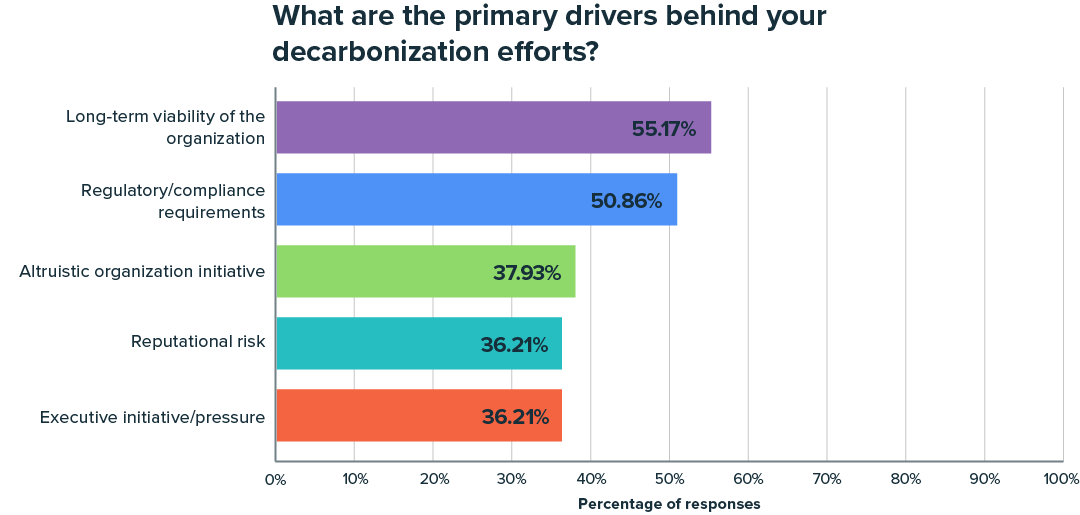
Decarbonization is more than compliance—it is also about creating lasting competitive advantage.
Long-term viability of the organization tops the list for the most important driver behind decarbonization efforts, followed by a close second of regulatory and compliance requirements.
What we think:
Based on the survey results, the main reason organizations are prioritizing decarbonization is because they believe it’s not just the right thing to do but something they must do to thrive in the long run.
Energy data (Scope 1 and 2) is a high priority for reporting.
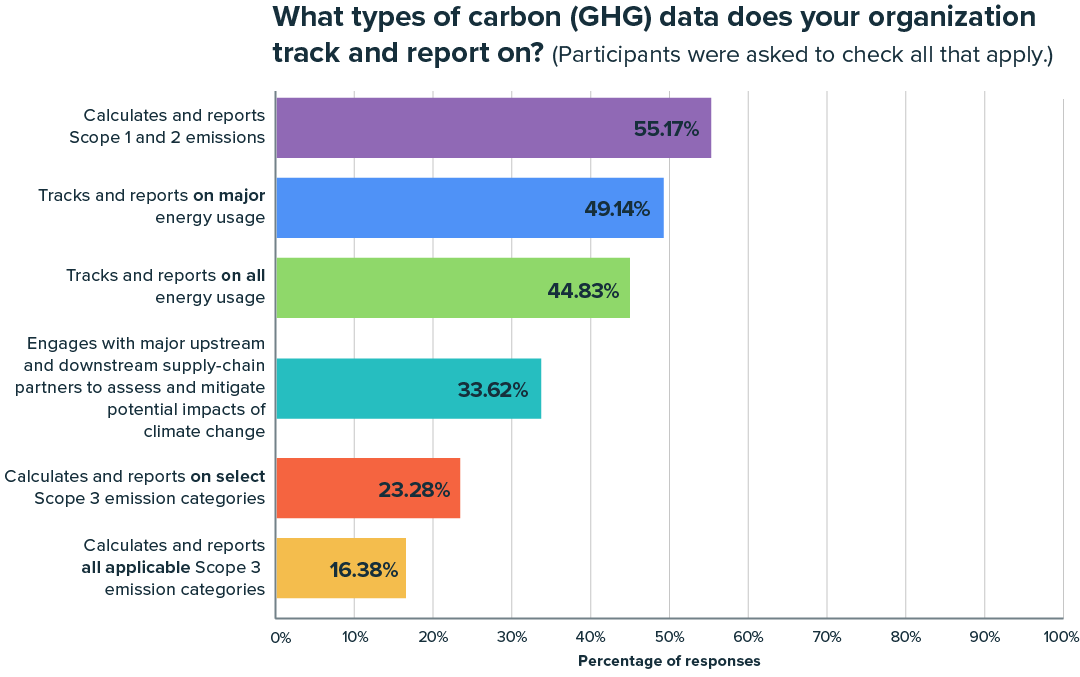
Scope 3 emissions often include a wide range of activities and can be more complex.
16.38% said their organization calculates and reports on all applicable Scope 3 emission categories. More than half said they calculate and report Scope 1 and 2 emissions.
What we think:
These results show that many organizations are really paying attention to tracking and sharing emissions they can directly control (Scope 1) and those related to their energy use (Scope 2). It highlights how important these types of emissions are when it comes to sustainability and environmental reporting.
Energy efficiency is the top priority.
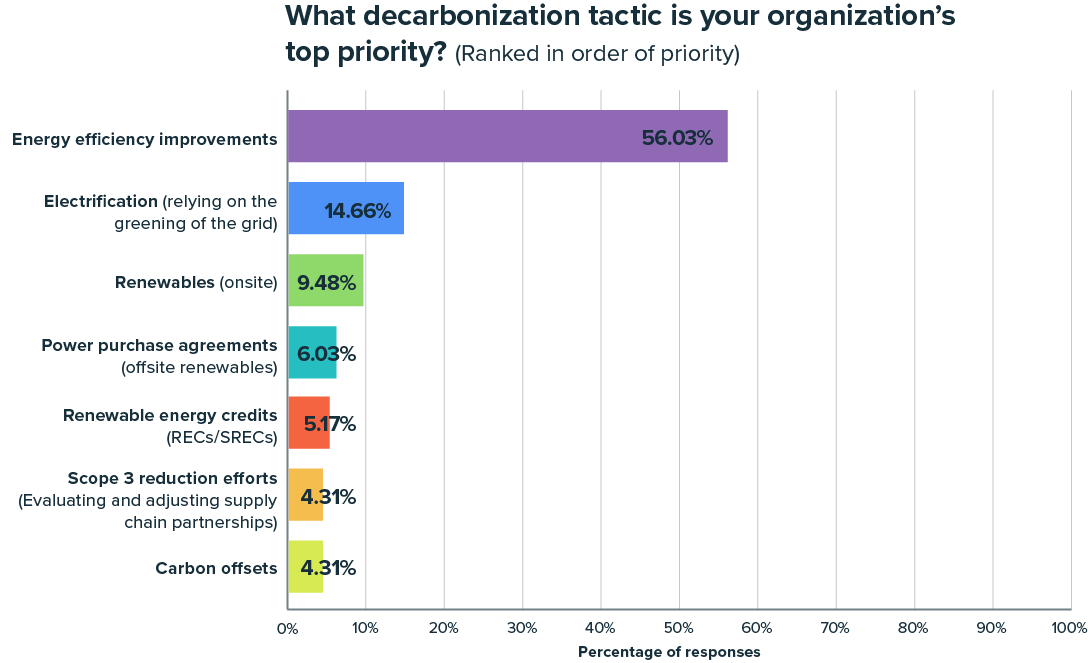
More than half ranked energy efficiency improvements as their top priority to meet decarbonization goals.
Less than 5% ranked Scope 3 reduction efforts and carbon offsets as a top priority.
What we think:
The survey indicates that energy-related initiatives take precedence among respondents, with a focus on efficiency, electrification, and renewables. Notably, over half of the participants consider improving energy efficiency as their top priority for achieving their decarbonization objectives. This emphasis on efficiency aligns with the earlier finding that Scope 1 and Scope 2 emissions are the top priorities for this group. While Scope 3 remains important for energy and sustainability leaders, the survey underscores the immediate urgency of optimizing operations for greater energy efficiency.
Data access is the #1 challenge in the journey to decarbonization.
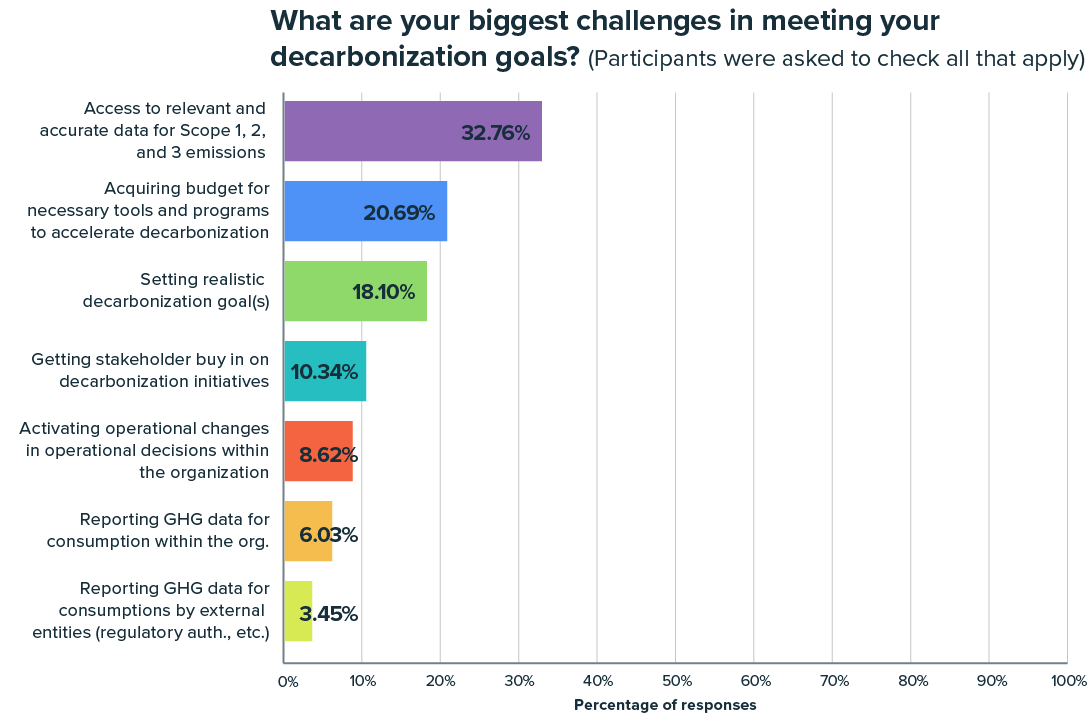
The biggest challenge in meeting decarbonization goals for organizations across industries is access to relevant and accurate data for Scope 1, 2, and 3 emissions.
What we think:
The significant challenge with availability of data underscores the growing importance for leaders to adopt software solutions for efficient data management to address this issue. We’ve always believed that utility bills are foundational in carbon accounting and a great place to start. At EnergyCAP, we offer solutions to assist in managing and leveraging this data for more effective emissions reporting and decarbonization strategies.
Annual data collection is where most organizations fall on the decarbonization data journey.
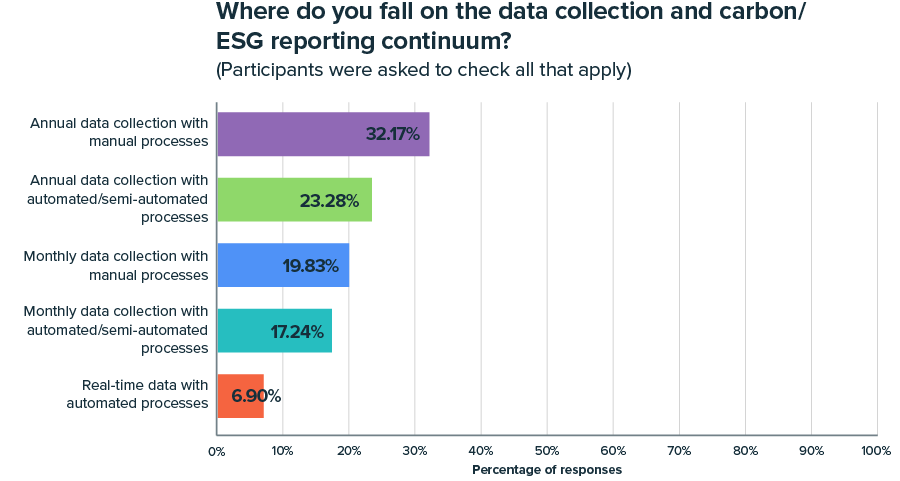
Most organizations do some form of data collection, but only 6.90% said they have real-time data with automated processes.
Most organizations fall under annual data collection with manual processes.
What we think:
The majority still rely on annual data collection through manual methods. While this is a good place to start, meaningful decarbonization demands a shift towards automated and real-time energy analytics. Access to such data is crucial for organizations to actively reduce emissions in their day-to-day operations.
Survey Questions
For this section, we left the questions open ended and optional to capture best practices, tips, and ideas from respondents. While we couldn’t include all responses, we listed the most helpful responses to each question.
What actions or changes do you think are necessary to accelerate the pace ofdecarbonization in the industry/economy?
“Education and workforce! Business owners, homeowners, building operators need to be educated about the benefits of decarbonization, which extend beyond the bottom line of profit. It is not always profitable to pursue electrification but in the long run we need to educate people about the importance of it. We also need more people in the local workforce – HVAC trades, electricians, weatherization specialists, and sustainability professionals to move the needle on getting decarbonization projects done.”
“We need to measure and act at the same time. Barriers to large improvements need to be made (i.e., govt/utility support for electrification) and the focus of mandates and incentives to encourage the transition to occur as quickly as possible is needed. There still exists many common sense decarbonization activities that do not require extensive measurement or testing to make immediate and meaningful improvements.”
“Mindset change is the biggest change. Things are being done focusing on regulatory and reporting compliance, by most of the organisations. It is necessary that compliance should be byproduct of such initiatives.”
“Discourage consumption by heavily taxing (a) carbon & (b) advertising that encourages consumption; Decision support systems for use in all executive decisions that provide guidance on carbon v/s profit impacts; Mandatory annual GHG reduction norms for all manufacturing and services; Linking executive compensation to GHG performance; Mandatory budgeting for and reporting of sustainability performance.”
What advice do you have for others on the journey to decarbonization?
“No one is perfect, and no system is going to be bulletproof – but you have to start somewhere. Jumping in and learning as you go is better than waiting until you have 100% of the information and planning in place.”
“Set Clear Goals: Define your decarbonization goals, both short-term and long-term. Having specific targets will help you measure progress and stay focused on your objectives. Start Small, Act Now: Begin with manageable steps that you can implement immediately. Small changes can have a significant impact when multiplied across a larger scale. Embrace Innovation: Be open to adopting new technologies and approaches. Innovation plays a vital role in driving decarbonization efforts and can lead to more efficient and sustainable solutions. Lead by Example: Whether you’re an individual or a business leader, your actions can inspire others. Showcase your commitment to decarbonization through your choices and practices. Plan for Transitions: If you’re a business or community, plan for the transition to cleaner technologies and practices. Develop a roadmap that outlines how you’ll phase out carbon-intensive activities and adopt sustainable alternatives. Stay Positive and Resilient: The journey to decarbonization can be challenging, but remember that every step you take contributes to a more sustainable future. Celebrate your successes and stay resilient in the face of obstacles.”
“Assess goals annually to see if they are still feasible. Work on improving data quality of your GHG inventory. Get external stakeholders involved in your decarbonization journey. Be open to researching scientific processes that aid decarbonization.”
What sources of information do you rely onto stay informed about decarbonization?
“Lots and Lots of webinars, newsletters, etc. EnergyCAP, Assent, Recycle newsletter, Udemy, ESG Reporting for Business, Sustainability Magazine, Carbon Accounting 101.”
“Research in the national labs on new technology and modeling resources. Organizations like RAP (Regulatory Assistance Project) looking athe policy side. State and Federal laws and policy regulations. Working directly with other building and campus operators.”
“Government Agencies: Websites of government agencies responsible for environmental and energy policy. Environmental NGOs: Non-governmental organizations (NGOs) focused on environmental issues, like the World Wildlife Fund (WWF) or Greenpeace, often provide valuable information International Organizations: Websites of international organizations like the United Nations, World Bank and IPCC.”
“Subscribe to various publications, become members of organizations advancing decarbonization, advocate and fund studies, provide grants, etc.”
“Newsletters from various organizations like ACEEE, BPA, BPI, RMI, Better Buildings Network, EPA, DOE, and building performance-specific organizations.”
To view all of the survey results, download the eBook.
 Best-in-class portfolio-level energy and utility bill data management and reporting.
Best-in-class portfolio-level energy and utility bill data management and reporting.
 Real-time energy and sustainability analytics for high-performance, net-zero buildings.
Real-time energy and sustainability analytics for high-performance, net-zero buildings.
 A holistic view of financial-grade scope 1, 2, and 3 carbon emissions data across your entire business.
A holistic view of financial-grade scope 1, 2, and 3 carbon emissions data across your entire business.
 Energy and sustainability benchmarking compliance software designed for utilities.
Energy and sustainability benchmarking compliance software designed for utilities.











